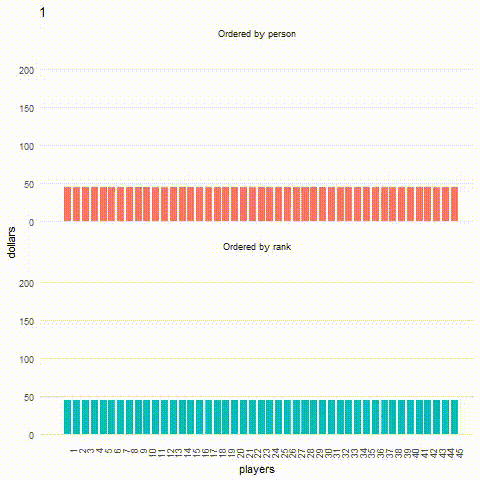Experiment: Does Financial Inequality Occur With a Random Distribution of Money?

Imagine that people locked in one room simply give each other money: each gives a dollar to someone else in a random order. How will the funds be distributed between these people? The answer may be surprising.
Challenge: how is money distributed by random distribution
The Decision Science News publication published material describing an unusual experiment:
')
“Imagine a room with 100 people at a time. Each of them has $ 100. Every second, each person in the room gives a dollar to one randomly selected person. How, after some time, will the money be distributed among all who are in the room? ”
For most of those who faced this task, the assumption itself arose that in the end everyone would receive approximately equal money. Even five doctors of science polled by Decision Science News reached the same initial conclusion. But is it really?
What the distribution looks like
How the funds will be distributed over time can be clearly seen here.

Infographics covers a time interval of 5000 seconds. The y-axis shows the amount of money that each participant in a mental experiment has. The countdown starts with $ 45. The X axis shows the number of people in the room - 45 people.
The red bars show how much money each person has every second. Blue bars are designed to demonstrate how wealth is distributed. The rightmost blue column corresponds to the highest red bar and so on.
You can check the experiment results yourself using the following code (you will need R , tidyverse and gganimate ):
library(tidyverse) library(gganimate) NUMPLAYERS = 45 ROUNDS = 5000 INITWEALTH = 45 #initialize the bank #columns wealths of the NUMPLAYERS players #rows show wealths of each of the ROUNDS ticks of the clocks bank = matrix(0, nrow = ROUNDS, ncol = NUMPLAYERS) bank[1,] = c(rep(INITWEALTH, NUMPLAYERS)) #function to give a dollar to someone other than oneself get_recipient = function(player) { sample(setdiff(1:NUMPLAYERS, player), 1)} #execute trades and update the ledger for (i in 2:ROUNDS) { #every player with wealth chooses another person to receive a buck recipients = sapply(which(bank[i - 1,] > 0), get_recipient) #table of the dollars owed each person count_table = table(recipients) #get the indices of the people owed money indices = as.integer(names(count_table)) #everyone gives up a dollar, unless they are at zero bank[i,] = ifelse(bank[i - 1,] > 0, bank[i - 1,] - 1, bank[i - 1,]) #selected people receive dollars bank[i, indices] = bank[i, indices] + count_table } ####################Animate it #Make a suitable long data frame df = as.data.frame(bank) names(df) = 1:NUMPLAYERS df = df %>% mutate(frame = 1:ROUNDS) %>% gather(person, wealth, 1:NUMPLAYERS) %>% mutate(person = as.numeric(person)) %>% arrange(frame) %>% group_by(frame) %>% mutate(rank = rank(wealth, ties.method = "random")) %>% ungroup() %>% gather(histtype,playerid,c(person,rank)) %>% mutate(histtype = sprintf("Ordered by %s", histtype)) p <- ggplot(df, aes(x = playerid, y = wealth, frame = frame, fill=histtype)) + theme_minimal() + theme(panel.grid.major.x = element_blank(), panel.grid.minor = element_blank()) + geom_rect(aes( xmin = playerid - .4, xmax = playerid +.4, ymin = 0, ymax = wealth)) + scale_x_continuous(breaks = 1:NUMPLAYERS) + coord_cartesian(xlim = c(0, NUMPLAYERS), y = c(0, 5 * INITWEALTH)) + theme(axis.text.x = element_text(angle = 90, hjust = 1)) + labs(x='players',y='dollars') + facet_wrap( ~ histtype,ncol=1) + theme(legend.position = "none") p #set options for the animation package. Need ImageMagick installed on your computer animation::ani.options(nmax = ROUNDS, convert = 'C:\\Program Files\\ImageMagick-7.0.6-Q16') #save the movie gganimate(p, "dollar_stacked.mp4", interval = .01) As you can see, inequality arises even under the most seemingly innocuous scenario. Therefore, it is necessary to monitor the distribution of finances.
Will the rich remain forever rich?
The mathematician Jordan Ellenberg explains that many believe that everyone will get approximately equal money if they are randomly distributed. In fact, it turns out that inequality in the distribution of finances appears almost immediately. Moreover, it persists as long as people continue to distribute money to each other at random.
Does this mean that as a result, some become rich and never lose their high position? Not at all. On the contrary, their well-being is changing all the time: every person gets richer with time, then becomes poorer.
Thus, in the long run, all money distribution options are equally likely. Observers of the experiment will be able to see a situation in which one person has $ 9,901 in his hands, and the other people have one dollar each, and the distribution of all funds is equal, as at the very beginning of the experiment.
Other materials on finance and stock market from ITinvest :
- ITinvest educational resources
- Analytics and market reviews
- How to determine the best time for a transaction in the stock market: Trend following algorithms
- How Big Data is Used to Analyze the Stock Market
- Finding inefficiencies: What you need to know about creating strategies for trading on the exchange
- Experiment: Using Google Trends to predict stock market crashes
Source: https://habr.com/ru/post/332854/
All Articles